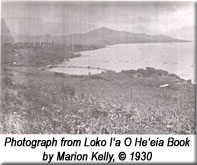 |
|
| History of Ancient Hawaiian Fishponds Fishponds were very abundant in prehistoric Hawai'i. Many fishponds are known to have been on the islands of Hawai'i, Maui, Lana'i, Moloka'i, O'ahu, and Kaua'i. Only in Hawai'i was there such an intensive effort to utilize practically every body of water, from seashore to upland forests, as a source of food, for either agriculture or aquaculture (Apple & Kikuchi, 1975). The general term for a fishpond is loko (pond), or more specifically, loko i'a (fishpond). Loko i'a were used for the fattening and storing of fish for food and also as a source for kapu (forbidden) fish. A fish was kapu to the Hawaiians during its spawning season to allow a variety of fish to reproduce. Although the chief or commoners were unable to catch fish in the sea at specific time spans, they were available in the fishponds because fishponds were considered a part of the land. Also, ocean fishing was dependent upon conditions of weather and surf. When there were storms and high surf, fish was always still available from the fishpond (Summers, 1964).
Construction of a fishpond was a huge task and any project undertaken for the good of the community was built through cooperation of all the families living in the ahupua'a. The konohiki (land administrator) would organize the work and be in charge of the contruction of the fishpond. Everyone who had worked during the building of the fishpond earned the right to share in the catch, and no one took more than they could use. Although the konohiki did not have exclusive rights to the fishpond, he could place a kapu on one kind of fish for his own use (Kelly, 1975).
History of He'eia Fishpond The
first recorded owner of He'eia Fishpond is High Chief Abner Paki. Paki
was the konohiki of the ahupua'a of He'eia by 1832.
He may have been appointed as konohiki because he was an intimate
friend of King Kamehameha III and held many positions of trust under
the King. Paki's wife was High Chiefess Laura Konia. Their daughter
was Princess Bernice Pauahi who later became the wife of Charles Bishop.
Princess Pauahi received 5,800 acres from her father, Paki, upon his
death (which included the ahupua'a of He'eia). Upon her death
of 1884, her estate (including He'eia) was passed into the hands of
Charles Bishop to establish and maintain a school for Hawaiian children.
Today, the Bishop Estate is managed by a Board of Trustees chosen by
the Justices of the Hawai'i Supreme Court. Therefore, He'eia Fishpond
is under the jurisdiction of Kamehameha Schools Bishop Estate (Henry,
1993). Between 1987 and 1999, six acres of He'eia Fishpond was leased to Mary Brooks, who was associated with an aquacultural commercial company. With a strong background in western aquacultural techniques, Mary was able to blend both Western and Hawaiian techniques together. The result was the ability to yield 70,000 pounds of moi (threadfish) annually and 1,000 pounds of Florida species Ogo (type of algae) weekly. Many were sold to various markets locally, nationally (California), and internationally (Canada). |
| |
||
|
Site maintained by . |
||

